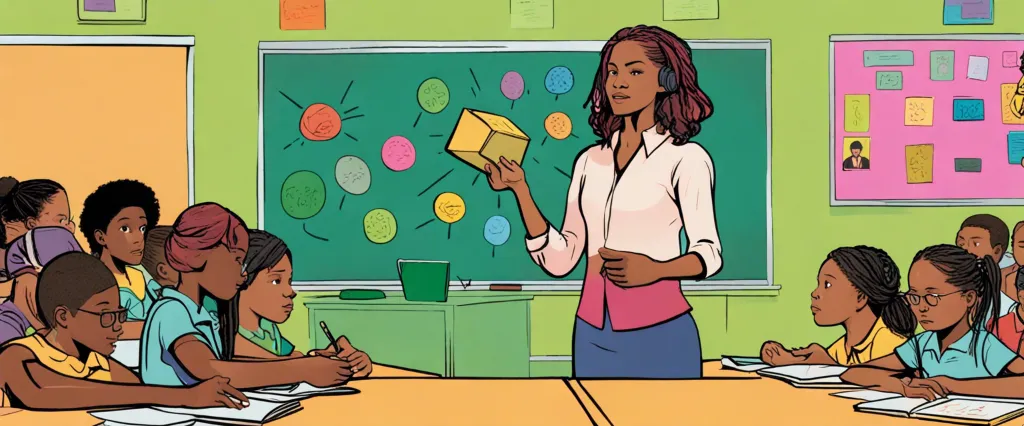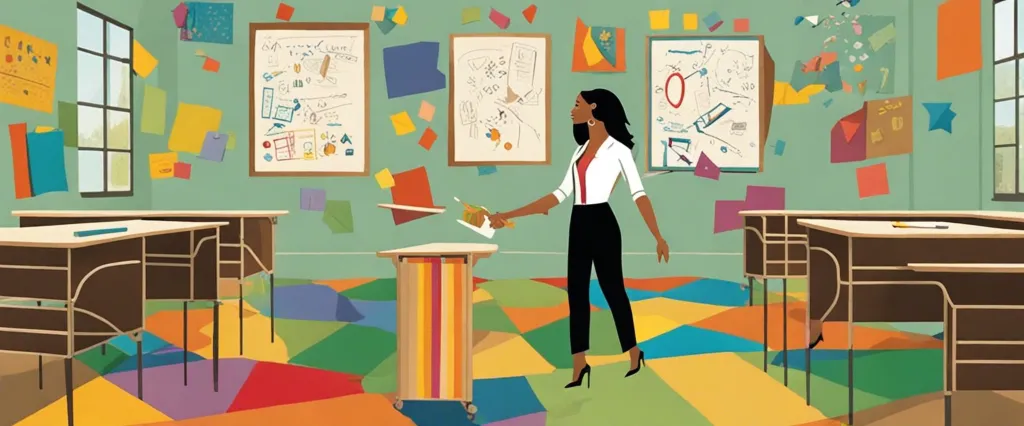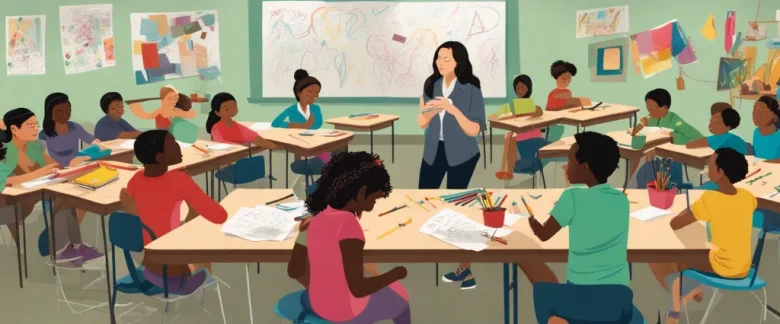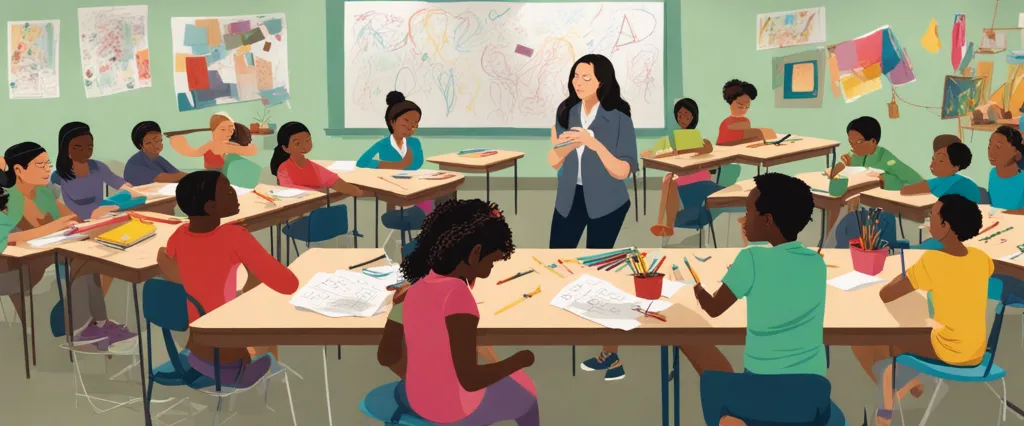In Teaching Outside the Box by LouAnne Johnson, the author offers a fresh perspective on teaching and encourages educators to break free from traditional methods in order to engage, inspire, and truly impact students’ lives. Johnson, known for her dynamic teaching style and her portrayal by Michelle Pfeiffer in the film “Freedom Writers,” draws from her years of experience as a high school teacher to provide practical strategies and innovative approaches that can transform the classroom environment. This summary delves into Johnson’s insightful ideas, presenting a glimpse into her dynamic teaching philosophy and her passion for empowering students to reach their fullest potential.
Chapter 1: Rethinking Education
In Chapter 1, titled “Rethinking Education,” LouAnne Johnson explores the inadequacies of traditional education systems and emphasizes the need for educators to adopt a more unconventional and engaging approach to teaching. Johnson, a former marine and teacher, shares her experiences and offers valuable insights on how to effectively engage students and create a conducive learning environment.
The chapter begins with Johnson questioning the traditional classroom setup that focuses on a teacher-centered approach, where students often take on a passive role in their education. She argues that this method fails to tap into students’ creativity, critical thinking skills, and motivation. Instead, she advocates for an active and inclusive learning environment that encourages students to own their education and take responsibility for their learning.
Johnson suggests that teachers need to adapt their teaching styles and approaches to connect with students on a personal level. She highlights the importance of building relationships, understanding students’ interests and strengths, and incorporating real-world examples into the curriculum. By doing so, teachers can create a meaningful and relevant learning experience that resonates with students and bridges the gap between the classroom and the outside world.
Moreover, Johnson challenges the notion that education is solely confined to academics. She emphasizes that children need to develop a range of skills beyond traditional subjects such as reading and math. These skills include problem-solving, critical thinking, communication, and adaptability, which are all essential for success in the real world.
In conclusion, Chapter 1 of “Teaching Outside the Box” urges educators to redefine the traditional education system and explore alternative teaching methods that foster active engagement, personal connection, and the development of diverse skills in students. Johnson’s insights prompt teachers to reflect on their practice and adapt their approach to meet the ever-changing needs of students.
Chapter 2: Creating a Positive Classroom Environment
Chapter 2 of “Teaching Outside the Box” by LouAnne Johnson focuses on the importance of creating a positive classroom environment. Johnson explains that building a positive classroom climate is crucial for promoting student engagement, motivation, and academic success.
The author emphasizes the significance of establishing positive relationships with students. She recommends getting to know each student personally, using their names, and showing genuine interest in their lives. Johnson also emphasizes implementing fair and consistent expectations and rules, which provide structure and security for students. When students feel respected and cared for, they are more likely to be engaged in their learning and exhibit positive behaviors.
Another key aspect discussed in this chapter is the importance of creating a sense of belonging within the classroom. Johnson encourages teachers to celebrate diversity and create an inclusive environment where all students feel valued and accepted. To achieve this, teachers can incorporate multicultural literature, expose students to various perspectives and backgrounds, and foster an atmosphere of acceptance, tolerance, and respect.
Johnson also discusses the impact of the physical environment on students’ well-being. She suggests creating a visually appealing and organized classroom that stimulates learning and creativity. Additionally, she shares strategies to manage noise levels, promote movement, and provide comfortable seating arrangements to enhance student focus and engagement.
The chapter concludes with the author highlighting the significance of positivity in teachers’ language and interactions. She suggests using encouraging and supportive language, providing constructive feedback, and fostering a growth mindset in the classroom. By creating a positive classroom environment, Johnson asserts that students will feel safe, supported, and motivated to learn, ultimately leading to increased academic achievement and a more enjoyable educational experience.
Chapter 3: Engaging Students through Active Learning
In Chapter 3 of Teaching Outside the Box by LouAnne Johnson, titled “Engaging Students through Active Learning,” the author emphasizes the importance of actively involving students in the learning process to enhance their understanding and retention of knowledge.
Johnson begins by highlighting the benefits of engaging students in hands-on activities and discussions, which promote critical thinking, problem-solving skills, and real-world application of concepts. She stresses that active learning allows students to become active participants in their education, rather than passive recipients.
The chapter presents various strategies to create an engaging classroom environment. Johnson suggests incorporating group work, where students collaborate and learn from one another. This not only promotes social interaction but also fosters a sense of community within the classroom. Through group work, students can develop teamwork skills, engage in meaningful dialogues, and benefit from diverse perspectives.
Furthermore, the author suggests using role plays or simulations as a way to bring concepts to life. This technique allows students to step into the shoes of a character or situation, making learning more experiential and memorable. Johnson also encourages using technology and visual aids to enhance student engagement and understanding.
To ensure that active learning remains effective, the author suggests setting clear objectives, providing guidance and structure, and giving students opportunities for reflection and feedback. She stresses the importance of connecting the learning material to students’ lives and interests, making it relevant and meaningful to their experiences.
Overall, Chapter 3 emphasizes the need for instructors to move beyond traditional lecture-style teaching and actively involve students in their own learning. By doing so, students become more engaged, motivated, and invested in their education, resulting in improved academic performance and a deeper understanding of the content.
Chapter 4: Differentiating Instruction

Chapter 4 of “Teaching Outside the Box” by LouAnne Johnson focuses on the concept of differentiating instruction in the classroom. The author emphasizes the need for teachers to recognize and address the diverse learning styles and abilities of their students.
Johnson begins by explaining that differentiation involves tailoring teaching approaches and content to meet the unique needs of each individual student. This provides an opportunity for all students, regardless of their background or abilities, to learn and succeed. The author emphasizes that differentiation supports the belief that all students can learn, but they may learn in different ways.
The chapter provides various strategies and techniques to implement differentiation effectively. Johnson recommends regularly assessing students’ learning styles and preferences to develop a customized approach for each student. This includes identifying visual, auditory, and tactile learners, as well as those who excel in group work or independent study.
The author also highlights the importance of providing multiple means of representation, expression, and engagement. This means presenting information in different formats, allowing students to demonstrate their understanding through various mediums, and engaging them in activities that suit their interests and strengths.
Johnson emphasizes the significance of fostering a positive classroom environment where students feel safe and empowered to take risks. By creating a sense of community and establishing high expectations, teachers support student growth and encourage a love for learning.
The chapter concludes by discussing the challenges that teachers may face when attempting to differentiate instruction. However, Johnson affirms that with proper planning, flexibility, and a genuine commitment to meeting students’ needs, differentiation can be successfully implemented in any classroom.
Overall, Chapter 4 of “Teaching Outside the Box” provides a comprehensive overview of the concept of differentiating instruction. It serves as a guide to help teachers recognize and celebrate the uniqueness of each student, in order to create an inclusive and effective learning environment.
Chapter 5: Technology in the Classroom
Chapter 5 of LouAnne Johnson’s book “Teaching Outside the Box” focuses on the integration of technology in the classroom. The chapter explores the various ways in which technology can enhance teaching and learning experiences, while also discussing potential challenges and how to overcome them.
Johnson begins by emphasizing that technology should not be viewed as a substitute for effective teaching, but rather as a tool to enhance instruction. She explains that incorporating technology in the classroom can make lessons more engaging and interactive, capturing students’ attention and encouraging active participation. Technology allows teachers to present information in different formats, giving students options to explore subjects in a way that suits their learning preferences.
The chapter suggests several ways in which teachers can integrate technology effectively. Johnson suggests using multimedia presentations, online resources, and educational software to supplement traditional teaching methods. She also encourages educators to embrace emerging technologies such as virtual reality and augmented reality, which can provide unique and immersive learning experiences.
Additionally, the chapter addresses the challenges that teachers may face when implementing technology in the classroom. These challenges include access to technology, student distraction, and the need for teacher training. Johnson emphasizes the importance of addressing these challenges and provides practical strategies for overcoming them. For instance, she recommends forming partnerships with local businesses or organizations to secure access to technology and using classroom management techniques to minimize distractions.
In summary, Chapter 5 of “Teaching Outside the Box” highlights the benefits of integrating technology in the classroom. It provides practical advice for teachers to enhance instruction by utilizing multimedia, online resources, and emerging technologies. The chapter also discusses potential challenges and offers strategies for teachers to overcome them, ensuring a successful integration of technology in the classroom environment.
Chapter 6: Cultivating Critical Thinking Skills
Chapter 6 of the book “Teaching Outside the Box” by LouAnne Johnson focuses on cultivating critical thinking skills in students. The chapter emphasizes the importance of teaching students how to think critically rather than simply memorizing information.
The chapter begins by explaining that critical thinking entails analyzing information, evaluating options, and drawing logical conclusions. It emphasizes that critical thinking skills are essential in today’s complex and rapidly changing world. Johnson suggests that critical thinking should be integrated into all subjects and taught explicitly to students.
Johnson provides various strategies to help teachers cultivate critical thinking skills in their students. She emphasizes the importance of fostering an environment that encourages students to question, explore, and engage in independent thinking. Teachers should provide opportunities for open-ended discussions, debates, and problem-solving activities.
Additionally, Johnson suggests incorporating activities that require students to analyze and evaluate new information. This can be done through the use of case studies, real-life applications, and projects that encourage students to think deeply and critically.
Furthermore, the chapter discusses the importance of teaching students how to ask meaningful questions. By teaching students to ask probing questions, teachers enable students to become active learners who take charge of their own learning.
Overall, Chapter 6 of “Teaching Outside the Box” highlights the significance of cultivating critical thinking skills in students. It provides practical strategies for teachers to promote critical thinking and empower students to become independent, lifelong learners who can analyze information, evaluate options, and make informed decisions.
Chapter 7: Assessing and Providing Feedback
Chapter 7 of “Teaching Outside the Box” by LouAnne Johnson focuses on the importance of assessing students’ progress and providing effective feedback to enhance their learning experience. In this chapter, Johnson explores various strategies that teachers can implement to assess students’ understanding, along with providing feedback that is meaningful and promotes growth.
Johnson emphasizes the significance of ongoing assessment to guide instruction and measure students’ progress. She highlights the importance of using a variety of assessment methods, such as individual projects, group work, and exams, to gather a comprehensive understanding of students’ learning. The author suggests that educators should also consider alternative assessments that allow students to showcase their understanding in creative ways, such as presentations or portfolios.
Additionally, Johnson emphasizes the concept of formative assessment, which involves monitoring student learning throughout the instructional process. This enables teachers to make timely adjustments to their teaching methods and provide immediate feedback to students. The author suggests utilizing both formal and informal formative assessments, such as quizzes, exit tickets, and class discussions, to gauge student understanding on a daily basis.
The chapter also discusses the significance of providing constructive feedback that supports growth and motivation. Johnson advises teachers to focus on specific aspects of students’ work, highlighting strengths and areas for improvement. By offering feedback that is clear, timely, and actionable, educators can help students understand where they have excelled and identify areas for growth. Johnson acknowledges the importance of maintaining a positive and encouraging tone while providing feedback, as it helps students feel supported and motivated to continue their learning journey.
In summary, Chapter 7 of “Teaching Outside the Box” emphasizes the importance of assessment and feedback in promoting student growth. Johnson provides practical strategies for teachers to implement ongoing assessment techniques and deliver meaningful feedback to enhance learning experiences for their students.

Chapter 8: Collaboration and Professional Growth
Chapter 8 of “Teaching Outside the Box” by LouAnne Johnson is titled “Collaboration and Professional Growth” and explores the importance of teamwork and personal development in the teaching profession. Johnson emphasizes that teaching can sometimes be an isolating profession, but collaboration with colleagues can lead to growth and improvement.
The chapter begins by highlighting the benefits of collaboration, including the sharing of ideas, support, and resources. Johnson suggests that teachers should actively seek out opportunities to collaborate with colleagues through team meetings, sharing lesson plans, or participating in professional learning communities. By collaborating, teachers can learn from each other’s experiences, generate new ideas, and solve problems together.
Additionally, Johnson stresses the significance of reflecting on one’s teaching practice in order to develop professionally. She advocates for self-analysis and encourages teachers to ask themselves questions such as “What went well in my lesson?” and “What changes can I make to improve student learning?” By reflecting on their teaching, educators can identify areas for growth, set goals, and strive for continuous improvement.
Furthermore, the chapter emphasizes the importance of seeking feedback from peers, mentors, and administrators. Johnson advises teachers to be open to constructive criticism and use it as an opportunity to enhance their teaching strategies. By actively seeking feedback and being receptive to suggestions, teachers can refine their practices and become more effective educators.
In conclusion, Chapter 8 of “Teaching Outside the Box” emphasizes the value of collaboration and professional growth in the teaching profession. By collaborating with colleagues, reflecting on their practice, and seeking feedback, teachers can enhance their teaching skills and continuously improve their impact on student learning.
After Reading
In conclusion, “Teaching Outside the Box” by LouAnne Johnson serves as an invaluable guide for educators seeking to enrich their instructional methods and connect with their students on a deeper level. Through her personal experiences and practical strategies, Johnson emphasizes the importance of stepping outside the traditional boundaries of teaching and embracing creativity, teaching to different learning styles, and cultivating a positive and inclusive classroom environment. By challenging conventional norms and customizing instruction to meet the needs and interests of individual students, educators can inspire a love of learning and empower their students to reach their full potential. “Teaching Outside the Box” prompts educators to think outside the box, challenging them to be innovative, compassionate, and dedicated to creating meaningful and transformative educational experiences.
1. “The First Days of School: How to Be an Effective Teacher” by Harry K. Wong and Rosemary T. Wong – This book provides practical strategies for new and experienced teachers alike, focusing on creating a positive classroom environment and establishing routines that foster student achievement.
2. “Teach Like a Champion: 49 Techniques That Put Students on the Path to College” by Doug Lemov – Lemov presents effective teaching techniques to engage students and promote a culture of learning. This book offers specific strategies to improve classroom management, student engagement, and academic achievement.
3. “Creative Teaching: An Evidence-Based Approach” by Robert J. Marzano – Marzano explores the importance of creativity in teaching, highlighting proven instructional strategies that foster innovation and critical thinking among students. This book provides practical advice for incorporating creativity into everyday lesson planning.
4. “The Growth Mindset Coach: A Teacher’s Month-by-Month Handbook for Empowering Students to Achieve” by Annie Brock and Heather Hundley – This book offers a guide to developing a growth mindset in both teachers and students, emphasizing the power of perseverance and a positive attitude. It provides practical strategies and activities to help students become more motivated and focused on their own learning.
5. “Teaching with Love and Logic: Taking Control of the Classroom” by Charles Fay and David Funk – Fay and Funk offer practical techniques for managing student behavior and fostering a positive classroom environment. This book emphasizes the importance of mutual respect, responsibility, and logical consequences in creating a productive learning space.




